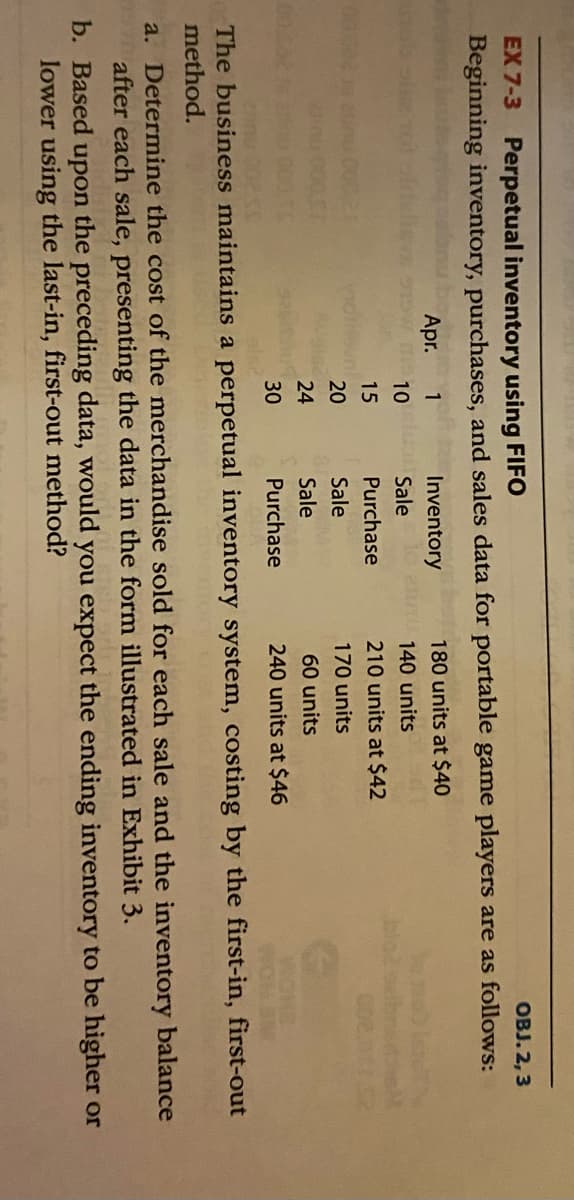woll aleo al ghn EX 7-4 Perpetual inventory using LIFOE lo alinu gniwollol od lo 120 blo2 OBJ. 2,3 Assume that the business in Exercise 7-3 maintains a perpetual inventory system, costing by the last-in, first-out method. Determine the cost of merchandise sold for each sale and the inventory balance after each sale, presenting the data in the form illustrated in Exhibit 4. alance, 40
woll aleo al ghn EX 7-4 Perpetual inventory using LIFOE lo alinu gniwollol od lo 120 blo2 OBJ. 2,3 Assume that the business in Exercise 7-3 maintains a perpetual inventory system, costing by the last-in, first-out method. Determine the cost of merchandise sold for each sale and the inventory balance after each sale, presenting the data in the form illustrated in Exhibit 4. alance, 40
Accounting (Text Only)
26th Edition
ISBN:9781285743615
Author:Carl Warren, James M. Reeve, Jonathan Duchac
Publisher:Carl Warren, James M. Reeve, Jonathan Duchac
Chapter7: Inventories
Section: Chapter Questions
Problem 7.10EX: Perpetual inventory using FIFO Assume that the business in Exercise 7-9 maintains a perpetual...
Related questions
Topic Video
Question
EX 7-4
Perpetual inventory using LIFO
OBJ. 2, 3
Assume that the business in Exercise 7-3 maintains a perpetual inventory system, costing by
the last-in, first-out method. Determine the cost of merchandise sold for each sale and the
inventory balance after each sale, presenting the
data in the form illustrated in Exhibit 4.

Transcribed Image Text:onol gnniEX 7-4 Perpetual inventory using LIFO s lo elinu gniwolloi orT
OBJ. 2, 3
Assume that the business in Exercise 7-3 maintains a perpetual inventory system, costing by
the last-in, first-out method. Determine the cost of merchandise sold for each sale and the
inventory balance after each sale, presenting the data in the form illustrated in Exhibit 4.
balance,
840

Transcribed Image Text:EX 7-3 Perpetual inventory using FIFO
ОBJ.2, 3
Beginning inventory, purchases, and sales data for portable game players are as follows:
Apr.
1
Inventory
180 units at $40
10
Sale
140 units
15
Purchase
210 units at $42
20
Sale
170 units
24
Sale
60 units
30
Purchase
240 units at $46
WON SM
The business maintains a perpetual inventory system, costing by the first-in, first-out
method.
a. Determine the cost of the merchandise sold for each sale and the inventory balance
after each sale, presenting the data in the form illustrated in Exhibit 3.
b. Based upon the preceding data, would you expect the ending inventory to be higher or
lower using the last-in, first-out method?
Expert Solution
This question has been solved!
Explore an expertly crafted, step-by-step solution for a thorough understanding of key concepts.
This is a popular solution!
Trending now
This is a popular solution!
Step by step
Solved in 2 steps with 2 images

Knowledge Booster
Learn more about
Need a deep-dive on the concept behind this application? Look no further. Learn more about this topic, accounting and related others by exploring similar questions and additional content below.Recommended textbooks for you

Accounting (Text Only)
Accounting
ISBN:
9781285743615
Author:
Carl Warren, James M. Reeve, Jonathan Duchac
Publisher:
Cengage Learning

Corporate Financial Accounting
Accounting
ISBN:
9781305653535
Author:
Carl Warren, James M. Reeve, Jonathan Duchac
Publisher:
Cengage Learning

Accounting (Text Only)
Accounting
ISBN:
9781285743615
Author:
Carl Warren, James M. Reeve, Jonathan Duchac
Publisher:
Cengage Learning

Corporate Financial Accounting
Accounting
ISBN:
9781305653535
Author:
Carl Warren, James M. Reeve, Jonathan Duchac
Publisher:
Cengage Learning